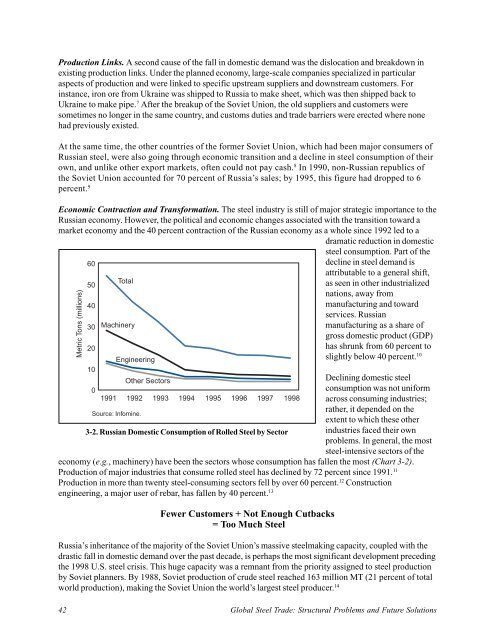Global Steel Trade; Structural Problems and Future Solutions
Global Steel Trade; Structural Problems and Future Solutions
Global Steel Trade; Structural Problems and Future Solutions
You also want an ePaper? Increase the reach of your titles
YUMPU automatically turns print PDFs into web optimized ePapers that Google loves.
Production Links. A second cause of the fall in domestic dem<strong>and</strong> was the dislocation <strong>and</strong> breakdown in<br />
existing production links. Under the planned economy, large-scale companies specialized in particular<br />
aspects of production <strong>and</strong> were linked to specific upstream suppliers <strong>and</strong> downstream customers. For<br />
instance, iron ore from Ukraine was shipped to Russia to make sheet, which was then shipped back to<br />
Ukraine to make pipe. 7 After the breakup of the Soviet Union, the old suppliers <strong>and</strong> customers were<br />
sometimes no longer in the same country, <strong>and</strong> customs duties <strong>and</strong> trade barriers were erected where none<br />
had previously existed.<br />
At the same time, the other countries of the former Soviet Union, which had been major consumers of<br />
Russian steel, were also going through economic transition <strong>and</strong> a decline in steel consumption of their<br />
own, <strong>and</strong> unlike other export markets, often could not pay cash. 8 In 1990, non-Russian republics of<br />
the Soviet Union accounted for 70 percent of Russia’s sales; by 1995, this figure had dropped to 6<br />
percent. 9<br />
Economic Contraction <strong>and</strong> Transformation. The steel industry is still of major strategic importance to the<br />
Russian economy. However, the political <strong>and</strong> economic changes associated with the transition toward a<br />
market economy <strong>and</strong> the 40 percent contraction of the Russian economy as a whole since 1992 led to a<br />
dramatic reduction in domestic<br />
steel consumption. Part of the<br />
60<br />
decline in steel dem<strong>and</strong> is<br />
attributable to a general shift,<br />
50<br />
40<br />
Total<br />
as seen in other industrialized<br />
nations, away from<br />
manufacturing <strong>and</strong> toward<br />
30<br />
20<br />
Machinery<br />
services. Russian<br />
manufacturing as a share of<br />
gross domestic product (GDP)<br />
has shrunk from 60 percent to<br />
slightly below 40 percent. 10<br />
Metric Tons (millions)<br />
10<br />
Engineering<br />
Other Sectors<br />
Declining domestic steel<br />
0<br />
consumption was not uniform<br />
1991 1992 1993 1994 1995 1996 1997 1998 across consuming industries;<br />
rather, it depended on the<br />
Source: Infomine.<br />
extent to which these other<br />
3-2. Russian Domestic Consumption of Rolled <strong>Steel</strong> by Sector industries faced their own<br />
problems. In general, the most<br />
steel-intensive sectors of the<br />
economy (e.g., machinery) have been the sectors whose consumption has fallen the most (Chart 3-2).<br />
Production of major industries that consume rolled steel has declined by 72 percent since 1991. 11<br />
Production in more than twenty steel-consuming sectors fell by over 60 percent. 12 Construction<br />
engineering, a major user of rebar, has fallen by 40 percent. 13<br />
Fewer Customers + Not Enough Cutbacks<br />
= Too Much <strong>Steel</strong><br />
Russia’s inheritance of the majority of the Soviet Union’s massive steelmaking capacity, coupled with the<br />
drastic fall in domestic dem<strong>and</strong> over the past decade, is perhaps the most significant development preceding<br />
the 1998 U.S. steel crisis. This huge capacity was a remnant from the priority assigned to steel production<br />
by Soviet planners. By 1988, Soviet production of crude steel reached 163 million MT (21 percent of total<br />
world production), making the Soviet Union the world’s largest steel producer. 14<br />
42 <strong>Global</strong> <strong>Steel</strong> <strong>Trade</strong>: <strong>Structural</strong> <strong>Problems</strong> <strong>and</strong> <strong>Future</strong> <strong>Solutions</strong>
















